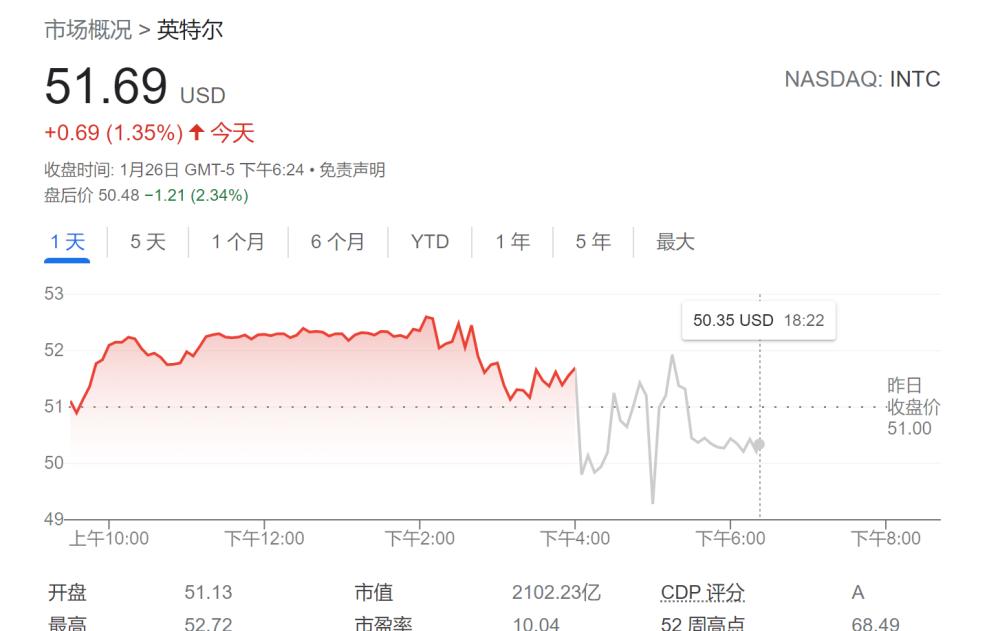Financial Associated Press (Shanghai, editor Huang Junzhi) - After business hours on Wednesday, Eastern Time, Intel announced its fourth fiscal quarter ended December 26, 2021. Although Q4 revenue and adjusted earnings per share both exceeded expectations, net profit for the current period fell by nearly 30%, bringing a slight shadow to investors.
As of press time, the company's stock price is down 2.59% in after-hours trading.

Intel's fourth-quarter adjusted earnings per share were $1.09, better than market expectations of $0.91; revenue of $19.5 billion, up 4 percent from $18.9 billion in the year-ago quarter and better than market expectations of $18.31 billion; and net income of $4.5 billion, down 27 percent from $6.1 billion in the year-ago quarter, according to earnings.
For the full fiscal year 2021, Intel's adjusted revenue was $74.7 billion, up 2% from $72.9 billion in fiscal 2020, net income was $22.4 billion, up 4% from $21.6 billion in the previous year, and earnings per share were $5.47, up 7% from $5.10 in the previous year.
Intel said it expects adjusted revenue to reach $18.3 billion in the first quarter of 2022, exceeding analysts' consensus estimate of $17.62 billion.
The PC business is strong
Sales at Intel's largest business, client computing Group, fell 7 percent year-over-year to $10.1 billion in fourth-quarter sales, but still higher than analyst average estimates of $9.6 billion, the data showed. Full-year 2021 revenue of $40.5 billion, up 1% compared to the previous year.
Intel CEO Pat Gelsinger said in an interview that the annual decline in the segment, which includes Intel's PC chip business, is the result of customers and PC makers shifting sales from one quarter to another. Since the start of the 2020 pandemic, including a quarter in December last year, personal computer sales have been on the rise.
"I wouldn't interpret the quarter-on-quarter numbers," Gelsinger said, adding that supply constraints were also a factor.
Gelsinger also said he expects PC sales to remain strong. Microsoft announced Tuesday that revenue from its personal computer business rose nearly 16 percent from a year earlier, beating expectations. Ceo Satya Nadella also said demand was strong across the business.
The data center business also exceeded expectations
In addition, revenue from Intel's Data Center Group also exceeded expectations, rising 20 percent to $7.3 billion, above the average forecast of $6.7 billion.
Gelsinger said, "In the fourth quarter, the company performed strongly, both internally, corporate and government. He added that some customers are having trouble getting parts like Ethernet power controllers that are necessary to build new Intel servers.
Gelsinger said the company's next-generation server chip, Sapphire Rapids, will begin shipping this quarter as planned and will increase production in the second quarter. Analysts had feared that the chip would delay production because it was a new process.
Mobileye, an Intel subsidiary focused on self-driving car technology, generated quarterly revenue of $356 million, up 7 percent year-over-year. Intel said in December that it planned to put the division public.
Expand capital expenditures
Less than a year ago, Gelsinger took over intel and began a period of massive capital expenditure. Under Gelsinger's leadership, Intel announced that it will continue to produce its own personal computers and server chips, and in the strategic shift, it will also start producing designs from other companies.
This strategy requires new facilities and investments. "First of all, we have to invest to catch up. We're lagging behind in terms of capacity, you know, we're hungry for some free capacity today," Gelsinger said.
Intel announced last week that it plans to build a chip production site in Ohio, which is expected to begin in 2025, and the base will house eight chip manufacturing plants. Intel said it would invest at least $20 billion to put the first two plants up and running. Last quarter, the company warned that its profit margins would shrink over the next two to three years as it invested in increased production capacity.
The final size of the Ohio complex is related to legislation on the Chip Act, which will provide $52 billion in subsidy funding for semiconductor companies. If the subsidies are approved, Intel could invest as much as $100 billion to build the plant. Last week, Gelsinger attended a White House event with President Biden to encourage Congress to pass the legislation.
Prior to investing in Ohio, Intel also announced plans last year to invest $20 billion to expand its existing production facility in Arizona.
In February, Intel will give investors a comprehensive overview of its strategic and technology roadmap, and investors are keeping a close eye on Intel's operating margins as the company invests in increased capacity. Gelsinger said Intel will also showcase its technology roadmap for consumer and data center chips.